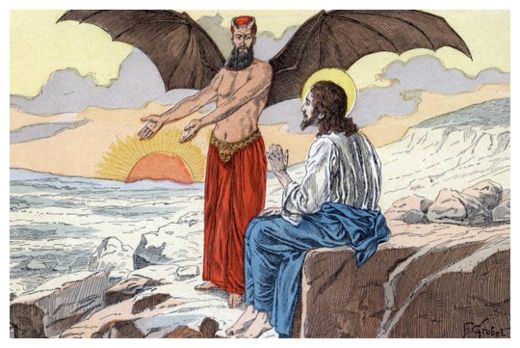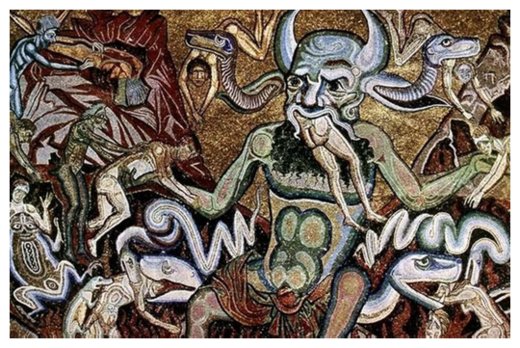
A giant beast, he stood frozen to the waist in a lake of ice in Dante's Divine Commedy, chewed on the damned in early Renaissance paintings, made a pact with Faust as Mephistopheles, rode a tank and "held a general's rank when the blitzkrieg raged and the bodies stank" -- if you trust the Rolling Stones.
A popular icon in the past, the devil appears to be alive and kicking also in Pope Francis' modernizing church.
The pontiff has alluded to him ever since his first homily as Pope, when he boldly quoted the French author Léon Bloy: "Anyone who does not pray to the Lord prays to the devil."
This week, speaking at a massive gathering in Rome's Olympic Stadium, Francis warned about the "devil wanting to destroy the family" and told married couples to raise children rather than owning pets. He ended his much-criticized remarks by portraying a life of loneliness and bitterness to those who love pets like they would children.
"Families face attacks from the devil because Jesus grows in parent's love and children's lives," he said.
But who, or what, is the devil?
A Literal Threat

For example, in the Old Testament, Satan is not the devil seen in horror movies.
"He is a loyal servant of God, and a relatively minor figure," Darren Oldridge, a specialist in early modern religious history and the author of several books on the devil, told Discovery News.
"The devil is far more prominent in the New Testament, and here he is emphatically the enemy of God and goodness," he said.
Often depicted as a rapacious monster through the Middle Ages, the devil was increasingly viewed as an invisible spirit of temptation during the 16th-century Protestant Reformation initiated by Martin Luther and John Calvin.
"More recently, some liberal Christians have understood Satan in metaphorical terms. But he remains a real presence among evangelical Protestants and Catholic traditionalists," Oldridge said.
The devil was indeed a real presence for Paul VI, Pope from 1963 to 1978. Back in 1972, he famously warned against the very physical "smoke of Satan" in the Church.
In another 1972 address, Paul VI called the devil "a living, spiritual being that is perverted and that perverts others."
"It is a terrible reality, mysterious and frightening," he concluded.
Although John Paul II agreed "the devil is still alive and at work," at a general audience in 1999 he smoothed over the strict, traditional Christian teachings by denying heaven and hell as physical places.
Rather than a physical place, John Paul II declared: "Hell is the state of those who freely and definitively separate themselves from God."
However, Francis's teachings on the devil appear to be more in line with Paul VI's old-school interpretations of Satan.
"Some of you might argue: 'Father, how old fashioned you are to speak about the devil in the 21st century," Francis recently said during a Mass at his Santa Marta residence. "But the devil is present! The devil is here... we mustn't be naive."

Unafraid of criticism for bringing back what many see as a reminder of the superstitions of the Middle Ages, the Vatican last month faced the demonic threat by hosting its largest convention on exorcism.
Called "Exorcism and Prayers of Liberation," the meeting included a six-day course to train about 200 Roman Catholic priests from more than 30 countries in the ancient rite of exorcism.
In 1999 the Vatican updated the exorcism ritual for the first time since 1614. The text to read during the exorcism remained essentially unchanged, but the church cautioned not to mistake mental illness for demonic possessions. It said that signs for a person being under the devil's control include speaking in a language the possessed person doesn't know and abnormal displays of strength.
There are currently some 250 exorcist priests in Italy, but many more are needed, said the meeting organizers.
"Just in the dioceses of Rome, we record a high percentage of calls requesting the services of an exorcist," said Cesar Truqui, a priest and exorcist from Switzerland.
It is said that Pope Francis himself performed an exorcism last year after his usual Wednesday audience in St. Peter's Square.
Although the Vatican denied the rite, TV footage showed a young man in a wheelchair, opening his mouth and either screaming or breathing deeply as Francis put his hands on his head. The man then convulsed and slumped in his chair.
Seriously Evil
According to Elaine Pagels, professor of religion at Princeton University and the author of The Origin of Satan, the idea of a continuous struggle between God's spirit and the devil prompted Christians to identify themselves with God from the very beginning.
They identified their opponents, whether Jews, pagans and heretics, as Satan, thus revealing new, social implications in the figure of the devil, which was used to identify enemies.
"For people who take the evil seriously, whether in the first century or the 21st, it's not just about some imaginarily contest of spiritual forces up in the stratosphere, it's also about seeing the world divided between those they see as 'God's people' and 'Satan's people'," Pagels told Discovery News.
"So when someone says, for example: 'Satan is trying to take over this country' -- that person probably could give you names and addresses of the people in mind," she said.



People greedily apoverishing others in weaker social positions, fighting wars, acting stupidly, destroying the planet, most of them pray to God. The Vatican in my eyes, like most religious sects are an instrument of the devil.
We must face it: most of our behaviour is programmed by spirits, thoughts, emotions, habits, which are entities, sometimes with very little consciousness, but very tenacious. Look at the consequences for the anglo-saxon world of the battle of Hastings, almost 1000 years ago ...
Britons for ever, ever, ever will be slaves ...
Meditate, increase your consciousness and reconquer your life.